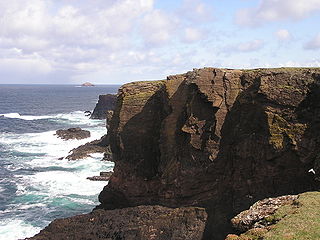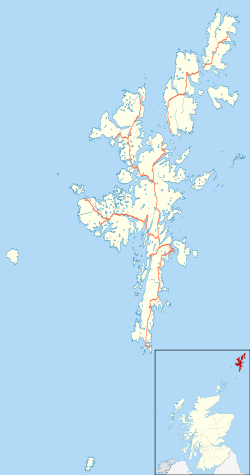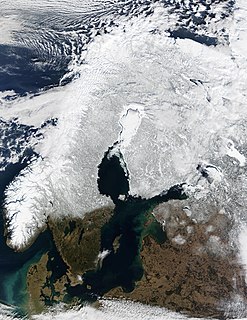
Mousa is a small island in Shetland, Scotland, uninhabited since the nineteenth century. The island is known for the Broch of Mousa, an Iron Age round tower, and is designated as a Special Protection Area for storm-petrel breeding colonies.
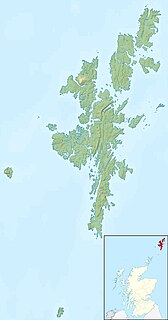
West Burra is one of the Scalloway Islands, a subgroup of the Shetland Islands in Scotland. It is connected by bridge to East Burra. With an area of 743 hectares (2.87 sq mi), it is the eleventh largest of the Shetland Islands.

East Burra is one of the Scalloway Islands, a subgroup of the Shetland Islands in Scotland. It is connected by a bridge to West Burra.

Birsay is a parish in the north west corner of The Mainland of Orkney, Scotland. Almost all the land in the parish is devoted to agriculture: chiefly grassland used to rear beef cattle. There are various ancient monuments in the parish.

Broch of Mousa is the finest preserved example of an Iron Age broch or round tower. It is in the small island of Mousa in Shetland, Scotland. It is the tallest broch still standing and amongst the best-preserved prehistoric buildings in Europe. It is thought to have been constructed c. 100 BC, one of more than 500 brochs built in Scotland. The site is managed by Historic Environment Scotland as a scheduled monument.
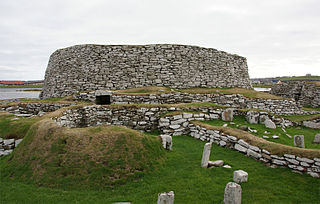
The Broch of Clickimin is a large, well-preserved but restored broch in Lerwick in Shetland, Scotland. Originally built on an island in Clickimin Loch, it was approached by a stone causeway. The broch is situated within a walled enclosure and, unusually for brochs, features a large "forework" or "blockhouse" between the opening in the enclosure and the broch itself. The site is maintained by Historic Scotland. According to its excavator, John R.C. Hamilton, there were several periods of occupation of the site: Late Bronze Age farmstead, Early Iron Age farmstead, Iron Age fort, broch period, and wheelhouse settlement.
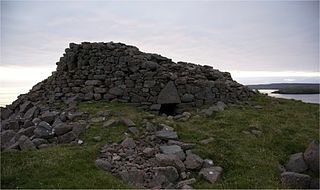
The Broch of Culswick is an unexcavated coastal broch in the Shetland Islands of Scotland. It has good views all around, including Foula and Vaila isles, and Fitful Head and Fair Isle in the south. The broch stands on the top of a rock platform and is about 3 metres high at its tallest point. Much rubble has fallen into the centre. This broch has a massive triangular lintel stone over the entrance, which is partly filled with rubble. Drawings by Low in 1774 and Skene in 1805 reveal that the structure survived very well up to those dates.
Haakon Paulsson was a Norwegian Jarl (1105–1123) and jointly ruled the Earldom of Orkney with his cousin Magnus Erlendsson. Their lives and times are recounted in the Orkneyinga Saga, which was first written down in the early 13th century by an unknown Icelandic author.

Burra is the collective name for two of the Shetland Islands, West and East Burra, which are connected by bridge to one another, and to the Shetland Mainland via Trondra. They form part of the Scalloway Islands

Burroughston Broch is an Iron Age broch located on the island of Shapinsay in the Orkney Islands, in Scotland. The site overlooks the North Sea on the northeast part of Shapinsay. Excavated in the mid 19th century, Burroughston Broch is still well-preserved. The drystone walls are up to four metres thick in some parts and there is a complete chamber intact off the entrance passage. Some remains of stone fittings are evident in the interior.

St Magnus Bay is a large coastal feature in the north-west of Mainland Shetland, Scotland. Roughly circular in shape with a diameter of about 19 kilometres (12 mi), it is open to the North Atlantic Ocean to the west. The indented coastline to the north, south and east between Esha Ness in the north and the Ness of Melby in the south contains numerous bays, firths and voes and there are several islands around the perimeter. The waters of the bay are up to 165 metres (541 ft) deep and may have been the site of a substantial meteor impact.
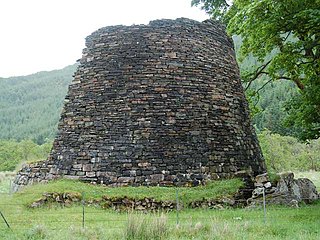
Dun Telve is an iron-age broch located about 4 kilometres (2.5 mi) southeast of the village of Glenelg, Highland, in Scotland. It is one of the best preserved brochs in Scotland.
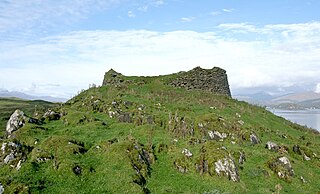
Tirefour Castle, is an Iron Age broch located 4 kilometres north of Achnacroish on the island of Lismore, Scotland.

Burra Ness Broch is an iron-age broch located on the east coast of the island of Yell, Shetland, Scotland.
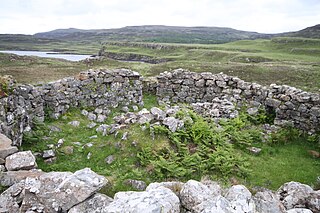
Dun Fiadhairt is an Iron Age broch located on the north coast of the island of Skye, in Scotland.

Dun Hallin is an Iron Age broch located near the northwest coast of the island of Skye, in Scotland.

Caisteal Grugaig is an Iron Age broch near the eastern end of Loch Alsh in the Scottish Highlands.

Dun Bharabhat is an Iron Age galleried dun or "semi-broch" situated on the island of Great Bernera near Lewis in Scotland.

The remains of the Orphir Round Church, dedicated to Saint Nicholas, are located in Orphir Parish on the Mainland of Orkney, Scotland. It is thought to have been built by jarl (earl) Haakon Paulsson as penance for murdering his cousin and co-ruler Magnus Erlendsson in the late 11th or early 12th century. According to the Orkneyinga saga, earl Haakon took sole power in 1117 after the killing of Magnus, and the round kirk was later rededicated to St Magnus. The saga refers to a "large drinking-hall" with a "magnificent church" nearby. The remains of the drinking hall, known as the Earl's Bu, can still be seen, as well as a later Norse horizontal watermill.



